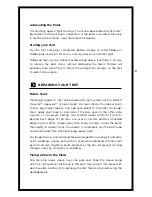
sEAM sEAliNg
The seams of your tent have been waterproof taped on all exposed
seams. All features, such as Velcro® pole anchors and door tiebacks, have
been welded onto the inside of the fly to avoid any small leak points.
However, for extremely wet and windy conditions, you may want to re-
seal selected parts of your tent. These include parts of the inner tent
where condensation or windblown rain could potentially wick through,
such as lantern loops or pole clip suspension points. You may also wish to
seal the “in” side of any untaped floor seams exposed to ground moisture
or rainfall. For seam sealing and tent repairs, we recommend a quality
after-market polyurethane sealer such as McNett Seam Grip®.
Work in a well-ventilated area to avoid inhaling sealant vapours. For
complete sealing, evenly apply only the minimum required amount of
sealant into needle holes, thread, and fabric joints. Allow to dry and cure
overnight. McNett sealants (Seam Grip and similar) cure more quickly in a
moist or humid environment. Before packing the tent for the first time, dust
newly sealed areas with talcum powder or spray them with 303
TM
Protectant;
freshly cured sealer can bond to itself even when dry. If the tent is used hard
and often you may need to reapply seam sealer in high-wear areas.
If the main panel of the front vestibule is rigged as a roof (see Step 5
of Attaching The Fly) water can potentially pool where the panel meets
the main fly, along the pole that runs over the door top. For this area at
least, we strongly recommend “touch up” sealing on the outside of the fly
where the hook-and-loop wrap-ties and toggle clips are sewn in.
siTE pREpARATiON
Remove sharp objects that might puncture the tent floor.
A ground sheet beneath the tent is not necessary for waterproofness,
but it will reduce long-term wear on the tent floor. A ground sheet should
be cut or folded smaller than the tent floor to prevent water pooling
between the floor and the ground sheet. Another light and convenient
option is MEC’s custom-made, coated nylon Footprint.
In winter conditions, we recommend digging out a platform with
surrounding walls. To avoid melting depressions in the snow under the
tent, pack the snow down solidly by ski or foot.
Summary of Contents for Frontenac
Page 10: ......




























